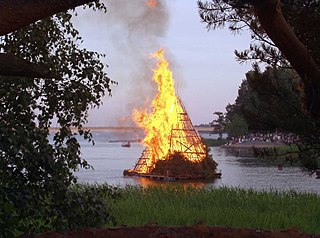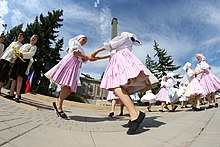
May Day is a European festival of ancient origins marking the beginning of summer, usually celebrated on 1 May, around halfway between the spring equinox and summer solstice. Festivities may also be held the night before, known as May Eve. Traditions often include gathering wildflowers and green branches, weaving floral garlands, crowning a May Queen, and setting up a Maypole, May Tree or May Bush, around which people dance. Bonfires are also part of the festival in some regions. Regional varieties and related traditions include Walpurgis Night in central and northern Europe, the Gaelic festival Beltane, the Welsh festival Calan Mai, and May devotions to the Blessed Virgin Mary. It has also been associated with the ancient Roman festival Floralia.

Carnival is a Christian festive season that occurs before the liturgical season of Lent. The main events typically occur during February or early March, during the period historically known as Shrovetide. Carnival typically involves public celebrations, including events such as parades, public street parties and other entertainments, combining some elements of a circus. Elaborate costumes and masks allow people to set aside their everyday individuality and experience a heightened sense of social unity. Participants often indulge in excessive consumption of alcohol, meat, and other foods that will be forgone during upcoming Lent. Traditionally, butter, milk, and other animal products were not consumed "excessively", rather, their stock was fully consumed during Shrovetide as to reduce waste. This festival is known for being a time of great indulgence before Lent, with drinking, overeating, and various other activities of indulgence being performed. For example, pancakes, donuts, and other desserts are prepared and eaten for a final time. During Lent, lacticinia and animal products are eaten less, and individuals make a Lenten sacrifice, thus giving up a certain object or activity of desire.

A bonfire is a large and controlled outdoor fire, used either for informal disposal of burnable waste material or as part of a celebration.

Midsummer is a celebration of the season of summer usually held at a date around the summer solstice. A variety of traditions have developed, linked to regions as well as religious practice.

Marzanna, Morė, Marena, Mara, Morana, Morena or Mora is a pagan Slavic goddess associated with seasonal rites based on the idea of death and rebirth of nature. She is an ancient goddess associated with winter's death, rebirth and dreams. In ancient Slavic rites, the death of the Goddess Marzanna at the end of winter becomes the rebirth of Spring of the Goddess Kostroma (Russian), Lada or Vesna representing the coming of Spring.

Festál is a free series of annual ethnically-related festivals that take place on the grounds of Seattle Center in Seattle, Washington. A major cultural program of Seattle, these festivals aim to celebrate and connect the city to its varied ethnic and international community. Most festivals contain various arts performances, dances, marketplace and other programs. These have also come to be the annual gathering place for ethnic groups of the community. Both older and younger people attend, especially the dances and musical concerts.

Lohri is a popular winter Dogra and Punjabi folk festival celebrated primarily in Northern India. The significance and legends about the Lohri festival are many and these link the festival to the Duggar region and Punjab region. It is believed by many that the festival marks the passing of the winter solstice. Lohri marks the end of winter, and is a traditional welcome of longer days and the sun's journey to the Northern Hemisphere by people in the northern region of the Indian subcontinent. It is observed the night before Maghi.

Jack in the Green, also known as Jack o' the Green, is an English folk custom associated with the celebration of May Day. It involves a pyramidal or conical wicker or wooden framework that is decorated with foliage being worn by a person as part of a procession, often accompanied by musicians.

Calan Mai or Calan Haf, also historically called Cyntefin, is the Welsh celebration of May Day. It marks the beginning of summer and traditionally it involved festivities around bonfires, maypoles, and carol singing. Some of its traditions parallel the Gaelic May Day festival Beltane, and other May Day traditions in Europe.

Shrove Monday, sometimes known as Collopy Monday, Rose Monday, Merry Monday or Hall Monday, is the Monday before Ash Wednesday every year. A part of the English traditional Shrovetide celebrations of the week before Lent, the Monday precedes Shrove Tuesday. As the Monday before Ash Wednesday, it is part of diverse Carnival celebrations which take place in many parts of the Christian world, from Greece, to Germany, to the Mardi Gras and Carnival of the Americas.

Lithuanian folk songs are often noted for not only their mythological content but also their relating historical events.

Moravian traditional music or Moravian folk music represents a part of the European musical culture connected with the Moravian region of the Czech Republic. Styles of Moravian traditional music vary by location and subject, but much of it is characterized by a specific melodic and harmonic texture related to the Eastern European musical world. According to Czech musicologist Jiří Plocek, Moravia is the area where the European East musically meets the West.

Hody is an annual traditional celebration held in many villages and towns of historical land Moravia in the Czech Republic. The festivity is held from May to November in almost all villages and towns of the cultural region of Moravian Slovakia. The time of the celebration differs - each village or town has a church building dedicated to a particular patron saint and usually the nearest Sunday after the date of the saint's day is also the date for celebration of Hody.

Danish folklore consists of folk tales, legends, songs, music, dancing, popular beliefs, myths and traditions communicated by the inhabitants of towns and villages across the country, often passed on from generation to generation by word of mouth. As in neighbouring countries, interest in folklore grew with an emerging feeling of national consciousness in 19th century Denmark. Researchers travelled across the country collecting innumerable folktales, songs and sayings while observing traditional dress in the various regions. Folklore today is part of the national heritage, represented in particular by national and local traditions, songs, folk dances and literature.
The Amis people of Taiwan celebrate many small and larger harvest festivals and ceremonies through the year.

Slavic carnivals are known under different names in various Slavic countries: Macedonian: Прочка, romanized: Pročka; Bulgarian: Сирни заговезни, Прошка, Поклади, romanized: Sirni zagovezni, Proshka, Pokladi; Russian: Масленица, Мясопуст, romanized: Maslenitsa, Myasopust; Polish: Ostatki, Mięsopust, Zapusty; Czech: Masopust, Šibřinky, Ostatky; Slovak: Fašiangy; Slovene: Mesopȗst, Pust, Pustni teden, Fašnk; Serbian: Покладе, Проћка / Poklade, Proćka; Croatian: Pust, Poklade, Mesopust, Fašnik. They are traditional Slavic festivals related to the period of carnival.
England traditionally celebrates a number of Christian and secular festivals. Most are observed throughout the country but some, such as Oak Apple Day, Souling, Rushbearing, Bawming the Thorn, and Hocktide, are local to certain regions.
Folk festivals are an important part of American community life. For the American people, popular folk festivals are important events composed of complex folklore phenomena. Folk festivals are generally used to celebrate folk music and traditional folk crafts, and some folk festivals are embodied in the form of dance and art. Some festivals are used to celebrate the harvest of crops or to gather people to watch performances and enjoy music, dance and folk culture on a specific day. These folk festivals can be categorized into music, dance, traditional culture and art as well as traditional crafts. Some folk festivals have a long history and they have been passed down from generation to generation. Even the folk festivals that have been recognized by people in recent years have received attention. There are hundreds of folk festivals in American waiting to be celebrated, and each festival has its own characteristics and style. As an inclusive country that incorporates a diverse culture, folk festivals are important events for the American people. More music festivals exist in American whether it is outdoors or indoors, the festival attracts a large number of visitors and tourists. This behavior not only promotes the economic development of every city in American, but also makes folk festivals more and more popular. In the American folk festivals, there are also some folk festivals for charity. These festivals will be held in the form of music festivals or festivals, and all the money received through the event will be used to finance poor children or for medical purposes. At the same time, some folk festivals that celebrate the harvest are also used as charity events. Crops and fruits obtained by farmers through labor are made into food or sold directly to tourists in exchange for money. These funds acquired on folk festivals are also used for charity. Folk festivals are not only a way for Americans to relax from their busy work, but also a symbol of history and culture.



















